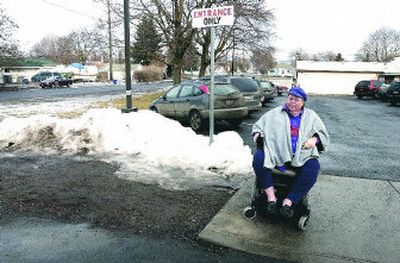Valley told to take concrete steps

Spokane Valley is where the sidewalk ends.
The city’s disorganized medley of subdivisions often stand out for their street-side basketball hoops, lengthy blocks and a lack of curbs that give them an almost rural feel.
The absence of modern pedestrian facilities, though, has a group demanding the city make its streets passable for the disabled.
“Thank God I have a cell phone,” said Shelly Mitchell of the Coalition of Responsible Disabled.
Several weeks ago, she came to the Valley to shop. She needed a few things from Wal-Mart and wanted to catch a sale at Harbor Freight a half mile down the road to complete a stereo system she’s been building for her wheelchair.
Although Sullivan Road is one of the busiest retail corridors in the Valley, the sidewalk was buried in snow. Mitchell became stuck on her way to Sprague Avenue.
After 40 minutes and a complaint to City Hall, she caught a lift with an employee from the city’s building department, which is responsible for enforcing a requirement that property owners keep sidewalks clear.
At a Jan. 23 meeting, she recounted the experience to the City Council and put them on notice that the coalition would lodge complaints with federal agencies if the city didn’t work toward compliance with the 1990 Americans with Disabilities Act.
“It just kind of got buried, and now it’s time to unbury it,” Mitchell said.
Before the city was voted into existence, Spokane County spent $205,000 improving buildings to comply with the federal legislation prohibiting discrimination against the disabled and ensuring them access to public facilities.
The county also spent $46,000 installing curb cuts at Sprague Avenue intersections, but there’s still some question as to whether all of the county’s sidewalk construction in the following years meets ADA requirements.
“I don’t want people in the Valley to think that we’re being unreasonable or trying to stir up trouble,” Mitchell said. Her group doesn’t expect problems to be fixed overnight, she said, but she wants to work with Spokane Valley and its disabled residents to fix areas where sidewalk upgrades are needed most.
The city can’t pour any new sidewalks this winter, Mayor Diana Wilhite said, but the issue will be a priority as the city puts together its next budget.
“We’re more than willing to work to get this resolved,” she said.
Soon, Spokane Valley will receive a comprehensive report on conditions of the streets it inherited from the county. The report doesn’t include information on sidewalks.
Although Spokane Valley repaved almost all of its roads in the past 20 years because of sewer installation, there’s been little done until recently to log or upgrade problem areas for pedestrians.
Sandra Lampe-Martin could point out quite a few.
“You’re taking your life in your hands every time you leave your house when you’re in a wheelchair,” Lampe-Martin said.
About eight disabled residents in the Edgecliff neighborhood like her navigate the shoulder in residential areas and the sparse curb cuts in sidewalks along busy commercial areas every day.
A 2-inch lip on a curb might not seem like much, but for Lampe-Martin it means running up enough momentum to get her wheels to hop onto the sidewalk, often pitching her forward and almost out of her chair.
When sidewalks or shoulders are covered in snow or turn to mud, her only option is to use the street.
“I get honked at a lot,” she said. “You hope they see you and they understand.”
Even when sidewalks are available on places like Sprague and Appleway, cross streets can be a half mile or more apart. Sometimes people in wheelchairs resort to finding driveways that line up across the street and cross there. Lampe-Martin said she thinks that’s what happened when a 56-year-old man in an electric wheelchair was hit by a truck on Mission Avenue in September.
“I know they can’t fix everything, but there are a few obvious things,” she said.
Mitchell’s group also asked the city to make businesses clear snow from the sidewalks in front of their properties.
With the exception of the sign code, the city currently enforces zoning code provisions, such as the shoveling snow, only when it gets a complaint about a specific property.
Upgrading the sidewalks to date has been a project-to-project issue, said Neil Kersten, city public works director.
Last year, the city improved curb cuts along Broadway after resurfacing there and has installed sidewalks in front of schools. A multi-use path is planned for 44th Avenue in the Ponderosa neighborhood this summer, and sidewalks are installed on all arterial projects that use state or federal funds.
Title II of ADA doesn’t require cities to build sidewalks along streets that don’t have them, but it does mandate that existing sidewalks be upgraded whenever substantial work is done to a road. It also requires city to develop a plan to bring sidewalks into compliance.